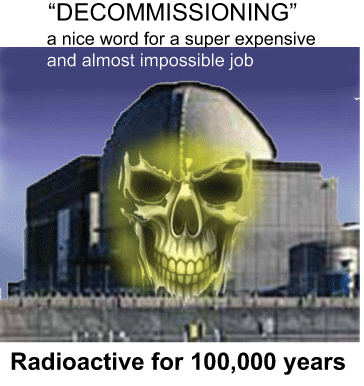North County Report: What’s the Deal with San Onofre’s Nuclear Power Plant?

Federal and public officials have been working to dismantle the San Onofre nuclear power plant for about a decade, but there’s still a long way to go. Here are the latest developments.
Voice of San Diego, by Tigist Layne, 24 Aug 23
“………………………………………………………. For the past several years, SoCal Edison has been dismantling the plant, a process known as decommissioning. Once that process is complete, the land will go back to its owner, the U.S. Navy.
Before that can happen, though, there’s the issue of the 3.55 million pounds of nuclear waste currently sitting inside the facility.
The latest: Manuel Camargo, principal manager of the San Onofre Decommissioning Project, said 50 percent of the plant has been decommissioned so far. The San Onofre Decommissioning Project was created by SoCal Edison.
As for the nuclear waste, also known as spent nuclear fuel, the Department of Energy is moving forward with a plan to transport the fuel into a temporary storage facility. Once that happens, officials can complete the decommissioning process.
Decommissioning of the Plant Is Carried Out in Three Phases
- First, after allowing the spent nuclear fuel to cool for a few years, the decommissioning team packaged the spent fuel into seal-welded stainless-steel canisters and transferred it to an onsite storage system. That transfer was completed in 2020, Edison International spokesperson Jeff Monford wrote in an email.
- Next is the demolition of above-ground structures like pressure vessels, pumps, motors, fans, cables and structural steel, which are removed from the buildings, packaged and sent offsite for disposal. The rest of the concrete structures are then demolished and transported to a disposal facility in Utah.
- Remaining underground structures will be decontaminated according to federal guidelines for cleanup of the site. The team anticipates this to be completed by 2028, Camargo said.

The final phase of decommissioning and site restoration will occur after the spent nuclear fuel is removed from the site.
The two containment domes are expected to come down sometime in 2025 or 2026.
The big storage issue: By now, you’ve probably gathered that without a place to store the spent nuclear fuel, the decommissioning can’t be completed. And there’s a reason it’s been so hard to find storage space: The federal government doesn’t have a single designated place in the United States to permanently store and/or dispose of spent nuclear fuel.
Let’s rewind to 1982 when the Nuclear Waste Policy Act became law. It established a national program for the disposal of highly radioactive waste and supports the use of deep geologic repositories to store and/or dispose of that waste.
A deep geologic repository is essentially a cavern a couple thousand feet below the Earth’s crust where the spent fuel would be placed, and it would stay there forever. It’s a way to store the waste while avoiding the contamination of the air, ground and underground water.

…………………………. until a permanent site is established by the federal government, the Department of Energy is stepping in.
……………………………………… ….Officials are planning to use consent-based siting to establish these storage facilities, meaning only cities and jurisdictions that are willing and able to store the spent nuclear fuel will be considered and chosen.
But these storage sites will be temporary. ……………………
The Department of Energy also needs approval from Congress to create these interim storage sites because the Nuclear Waste Policy Act would have to be modified to allow for it. It will also be up to lawmakers to eventually amend the act and establish another permanent deep geologic repository for spent fuel.
A few different groups are now working together to get this done: the Spent Nuclear Fuel Solutions Congressional Caucus established by Rep. Mike Levin; the Department of Energy; and the Spent Fuel Solutions coalition, which includes San Diego County, Orange County, Riverside County, SoCal Edison, San Diego Gas & Electric and the City of Riverside. https://voiceofsandiego.org/2023/08/23/north-county-report-whats-the-deal-with-san-onofres-nuclear-power-plant/
No comments yet.
-
Archives
- May 2024 (249)
- April 2024 (366)
- March 2024 (335)
- February 2024 (345)
- January 2024 (375)
- December 2023 (333)
- November 2023 (342)
- October 2023 (366)
- September 2023 (353)
- August 2023 (356)
- July 2023 (362)
- June 2023 (324)
-
Categories
- 1
- 1 NUCLEAR ISSUES
- business and costs
- climate change
- culture and arts
- ENERGY
- environment
- health
- history
- indigenous issues
- Legal
- marketing of nuclear
- media
- opposition to nuclear
- PERSONAL STORIES
- politics
- politics international
- Religion and ethics
- safety
- secrets,lies and civil liberties
- spinbuster
- technology
- Uranium
- wastes
- weapons and war
- Women
- 2 WORLD
- ACTION
- AFRICA
- Atrocities
- AUSTRALIA
- Christina's notes
- Christina's themes
- culture and arts
- Fuk 2022
- Fuk 2023
- Fukushima 2017
- Fukushima 2018
- fukushima 2019
- Fukushima 2020
- Fukushima 2021
- general
- global warming
- Humour (God we need it)
- Nuclear
- RARE EARTHS
- Reference
- resources – print
- Resources -audiovicual
- World
- World Nuclear
- YouTube
-
RSS
Entries RSS
Comments RSS


Leave a comment